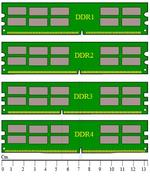
Switch vs. Router: Key Networking Differences Explained
Understand the core differences between network switches and routers, including their functions, layers of operation, and roles in local and wide area networks.
Showing 20 posts (Page 3 of 4)
Advertisement

Understand the core differences between network switches and routers, including their functions, layers of operation, and roles in local and wide area networks.

Understand the difference between throughput and bandwidth in networking. Learn how they're measured and how they affect your network performance.

Explore the key differences between Thunderbolt 4 and Thunderbolt 3, including their features, specifications, and performance enhancements.

Explore the pros and cons of the Thunderbolt interface, including data transfer speeds, cost, and device availability.

Explore the key differences between Thunderbolt and USB interfaces, including speed, power, compatibility, and use cases. Understand Thunderbolt 3 and USB-C capabilities.

Explore the TransferJet physical layer, vital for ultra-fast and secure wireless data transfers. Understand its operation and features through its transmitter block diagram.

Explore TransferJet: a high-speed, close-proximity wireless tech. Learn about its features, working principles, frame structure, and comparison with WiFi and NFC.

Explore the benefits and drawbacks of UART (Universal Asynchronous Receiver/Transmitter) communication, its features, and applications.

Explore the advantages of UFS storage (versions 2.0 to 3.1) over e-MMC, including enhanced speed, lower latency, reduced power consumption, and improved IOPS in mobile devices.
Explore the concept of data rate in wireless communication, its calculation, and typical data rates for various wireless technologies like GSM, LTE, and more.

Explore DDR SDRAM, its evolution from DDR1 to DDR4, and its advantages in speed, power efficiency, and system performance over SDR SDRAM.

Explore Plastic Optical Fiber (POF) technology, including its workings, advantages, disadvantages, and applications in various industries.

Explore USB's architecture, connectors, protocols, and benefits. Learn how USB facilitates data transfer and power delivery between devices.
Explore the pros and cons of USB technology, including its versions, functionality, benefits, and limitations in modern connectivity.
Explore the fundamentals of Wireless USB, its advantages over wired USB, and key technical distinctions, including speed, security, and compatibility.

Explore the differences between USB 2.0 and USB 3.0, including data transfer speeds, power consumption, and backward compatibility.

Compare USB 2.0, USB 3.0, and MIPI CSI-2 interfaces for embedded systems, highlighting bandwidth, space, and development costs.
A concise comparison of USB 3.0 and USB 3.1, highlighting their differences in speed, power, and compatibility for better understanding.
Explore the differences between USB 3.1 Gen1 and Gen2, including transfer rates and common names. Understand which USB version suits your needs.
Explore the distinctions between USB 3.1 and USB 3.2, including their speeds, versions, and key features.
Advertisement